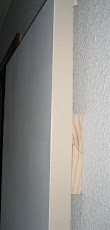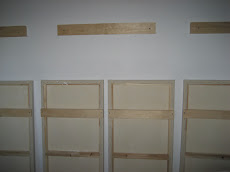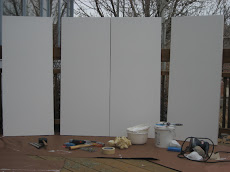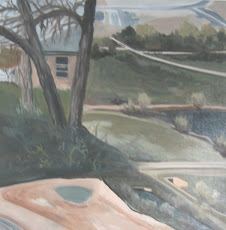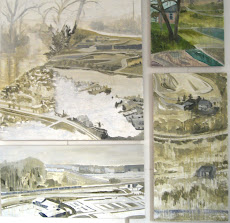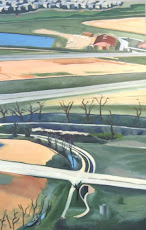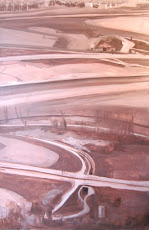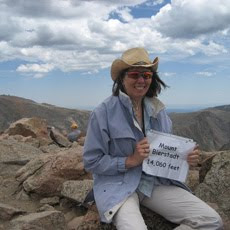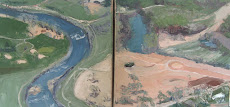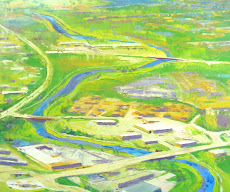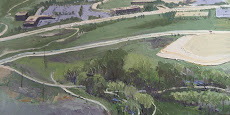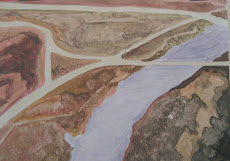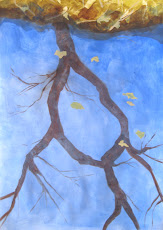I decided to keep the gray values in the "sky" of the ground view and completed the rest of the 4 panels with muted colors mixed with mars black, white, venetian red, and yellow ochre.
Tuesday, March 23, 2010
Stages of Completion
Since I wasn't sure how I was going to combine the aerial and ground level views in my new multi-canvas painting, I started with the aerial view on all 4 panels in gray scale. Then I layered the ground view over the aerial on the 2 center panels.
Monday, February 1, 2010
Hanging System
Creating a modular grouping of canvases required a more secure hanging system than the wire that I usually attach to the back of my paintings. One of my classmates from my AIB critique group, Jeff, suggested a "french cleat" system". With the help of my neighbor and his table saw, as well as my husband's coaching on using his power tools, I have installed the hanging system at home to make sure it works before I start painting.
Wednesday, January 20, 2010
Ready to paint
Decisions about materials and sizes are as important to me as the ideas and subject matter that I paint. I've been thinking about doing a triptyk with a square painting in the center and two narrow paintings on the sides.
My next multi-canvas piece will emphasize multiple view points by being composed of interchangeable panels that can be hung a variety of ways to show different viewpoints of the suburban landscape.
My thoughts about painting a triptych have evolved into painting a 4 panel piece, that will be composed of 2 images, each on 2 panels. The panels will be hung so that the center painting will consist of 2 panels together, with the other image divided and hung on each side. Instead of a square painting in the middle, the dimensions of each panel are 48x20, with the center painting of 2 panels being 48x40. This multi-paneled piece can also be changed to alternate images.
The flexibility allowed by stretching my own canvases has enabled me to choose the exact dimensions I want to paint and to design the hanging system as part of preparing the canvas. As I have already invested time and energy in these surfaces that same attention to detail will continue as I apply the paint.
Thursday, January 14, 2010
ICA Boston
Saw some interesting work today at the ICA Boston. Noriko Furunishi combines and collages her landscape photos to create surrealistic expansive landscapes.
My approach is similar to this in that I am also using landscape photos and collage-like process to create new images. Unlike Furunishi, I paint the images after combining them.
This leads to the question my mentor has taught me to ask: what can paint add to the image?
Why not just enlarge these combined photos and simplify my process?
In the process of painting the image is transformed into something I have visualized. My interpretation of the idea becomes more evident as I work with the image and the concepts I am seeking to make visible. As I leave out the unnecessary and add in the parts that are missing, I make the painting more specific to my ideas, and less about the location in which the photographs were taken. The marks that I make with paint contain my thoughts in a liquid form. I can work with the extremes of light to dark and transparent to opaque. The application of paint can reveal not only the motion of the painter's hand, but also the attitude with which he or she has approached the painting. The intensity or carelessness of the artist's handling of the paint becomes another form of communication. It can also serve to emphasize the ideas behind the painting, which in my case, are the transformation of the land and the multiple viewpoints from which the landscape can be viewed. Can the new beauty of the urban landscape compete with the picturesque rural landscape? Maybe they are both present depending on your point of view.
Friday, December 4, 2009
Last Homestead in process
My recent paintings are part of a series called Last Homestead. The title refers the home that remains in the center of construction along the bike path. Each painting shows either the house itself or the area around it from both aerial and ground level views. I am exploring ways to show the inevitable change that is now a significant part of our American lifestyle. There is tension between the disappearance of the familiar and the emergence of newer and better opportunities.
Three of these paintings are still in the final stages of the underpainting in which I used a limited palette of black, white, yellow ochre, and burnt sienna. While experimenting with oil glazes on the 20x20 I learned that I need to tone down my transparent oil colors to get the effect that I am looking for. That painting has since been re-painted with the limited palette.
Sunday, November 1, 2009
Friday, October 23, 2009
Painting in Process
Encouraged to work larger, I am painting a 60 x 40" aerial view entitled Beyond the Bikepath.
I painted the monochromatic underpainting with acrylics. Now that I have blocked in the colors I think that the freshness of the underpainting is more successful than the colored version. I'm going to experiement with a limited palette and perhaps change the colors again once I have done these experiments.
I painted the monochromatic underpainting with acrylics. Now that I have blocked in the colors I think that the freshness of the underpainting is more successful than the colored version. I'm going to experiement with a limited palette and perhaps change the colors again once I have done these experiments.
Subscribe to:
Comments (Atom)


